Úbeda and its sister town,
nearby Baeza, are by far the two most Renaissance of
towns in Andalusia. For Úbeda, this happened when
a deep-pocketed noble named Francisco de los Cobos
accompanied his Emperor to Italy -- and brought back the
High Renaissance. He hired the best architect of his day
-- but ended up with the man’s apprentice, a young
stone mason named Andréa Vandelvira who would go
on to make Úbeda a town much copied in Spain and
the New World.
Úbeda has had some tough
times before and since: After being captured by King/Sain
Fernando III and the Christians in 1233, it was on the
firing line for 250 years until the Moors were driven
from Granada. During
that time, a 1368 war over the Spanish succession all but
leveled the town. Since then the 1755 Lisbon earthquake
(a Richter scale 9!) and the Spanish Civil War of the
1930s have further increased the havoc and
destruction.
Yet what’s left is a stone feast for the eyes;
over 48 buildings are still classified today as monuments
and UNESCO made the town a World Heritage site in 2003.
Plaza Vazquez de Molina

Perhaps the most magnificent Renaissance square in all
of Andalusia is Úbeda's Plaza Vazquez de Molina.
Once the old market square, it acquired its present set
of Renaissance buildings mostly in the 16th century when
the ministers of Spain’s new Emperor funded
Andalusia's most famous Renaissance architect to line
this area with palaces. Of the many beautiful buildings
that edge this square, four standout (clockwise from
upper left): Capilla del Salvador, Palacio de las
Cadenas, The Parador, and Iglesia de Santa Maria de los
Alcazares.
Palacio de las Cadenas -- the Palace of Chains
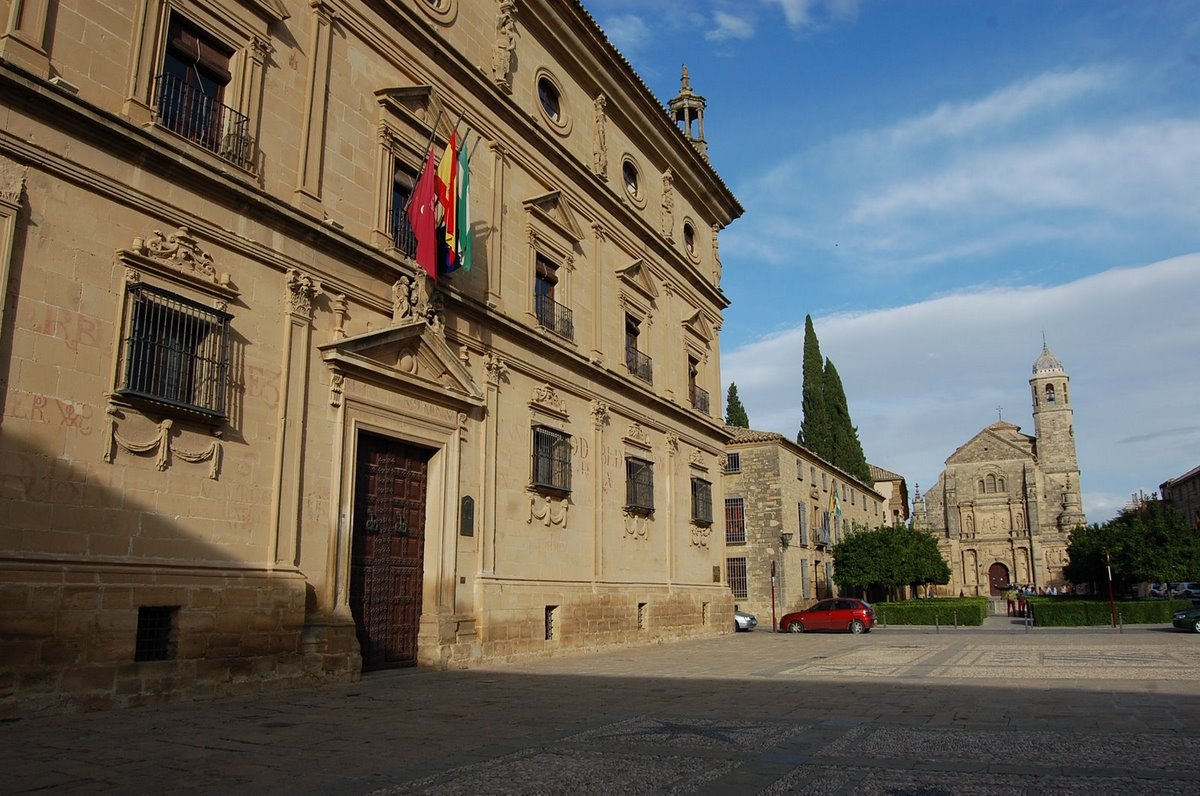
Úbeda is not only important in its own right, but
its architecture and city-planning inspired much other
building in Spain and in Latin America. Part of this was
due to Renaissance Andalusia's greatest architect,
Andréa Vandelvira, who left behind
his
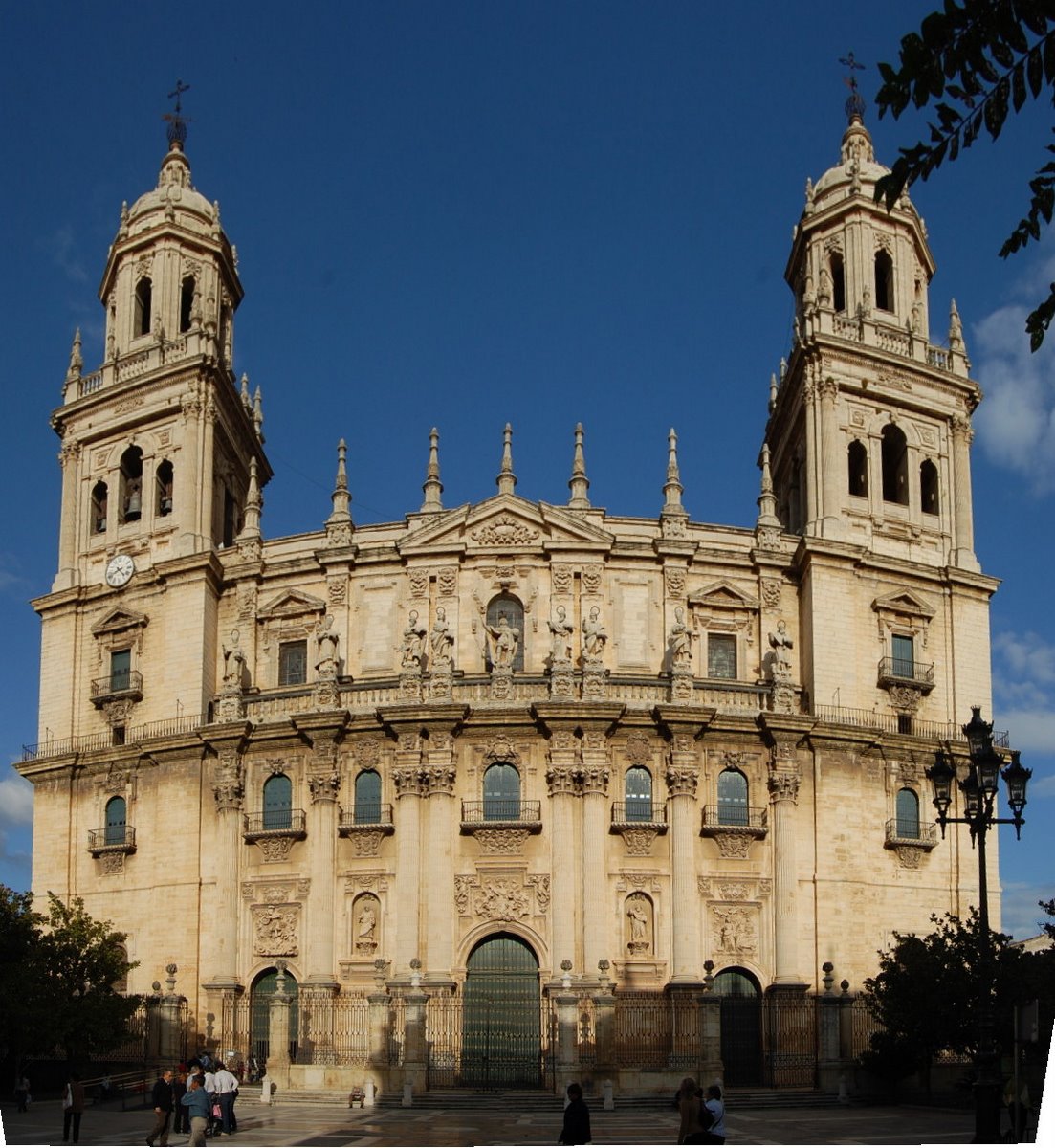 legacy in stone here and through
his son’s writings. In a time of very little formal
training for architects, these influenced many builders
who followed. Above we look from the Palacio de las
Cadenas towards the Chapel of our Savior. Note that the
red car is parked on the street, not on the plaza. (More
on that later).
legacy in stone here and through
his son’s writings. In a time of very little formal
training for architects, these influenced many builders
who followed. Above we look from the Palacio de las
Cadenas towards the Chapel of our Savior. Note that the
red car is parked on the street, not on the plaza. (More
on that later).
Does the picture at right look familiar? We saw this
great Renaissance cathedral near Úbeda in its
provincial capital of Jaen. It’s the religious masterpiece of
Andréa Vandelvira. While Úbeda has no
church on this scale, Vandelvira’s secular architecture here is
spectacular. (If you want to see Vandelvira's
masterpiece in Jaen, click here.)
Back to Úbeda now where we see another three-story
façade with two "steeples" at either end: The
Palacio de las Cadenas (above and below). This is one of
Vandelvira's most important secular buildings. Its name
comes from its time as the jail when chains were
stretched across its entrance. It has also been used as a
Dominican nunnery and is now a triple threat as a pottery
museum, archive, and Úbeda's city hall.
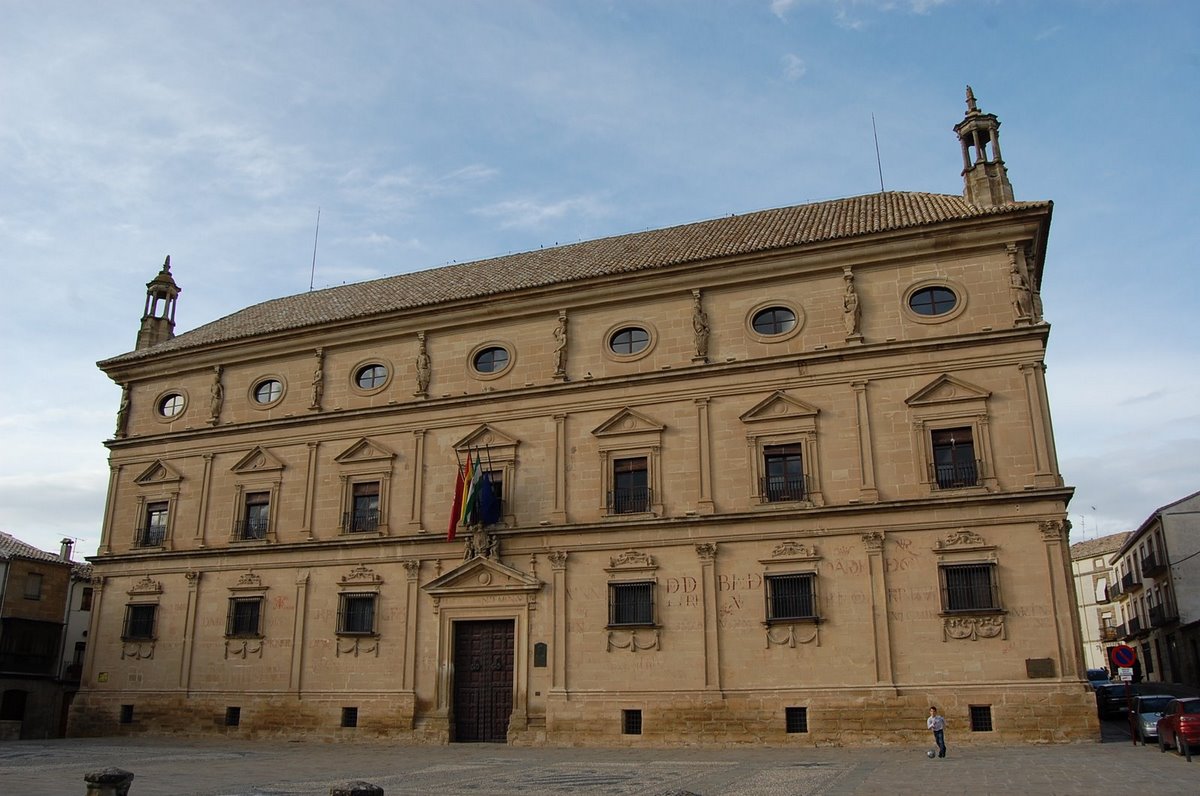
Look carefully at the top floor where we see the
circular windows separated ...
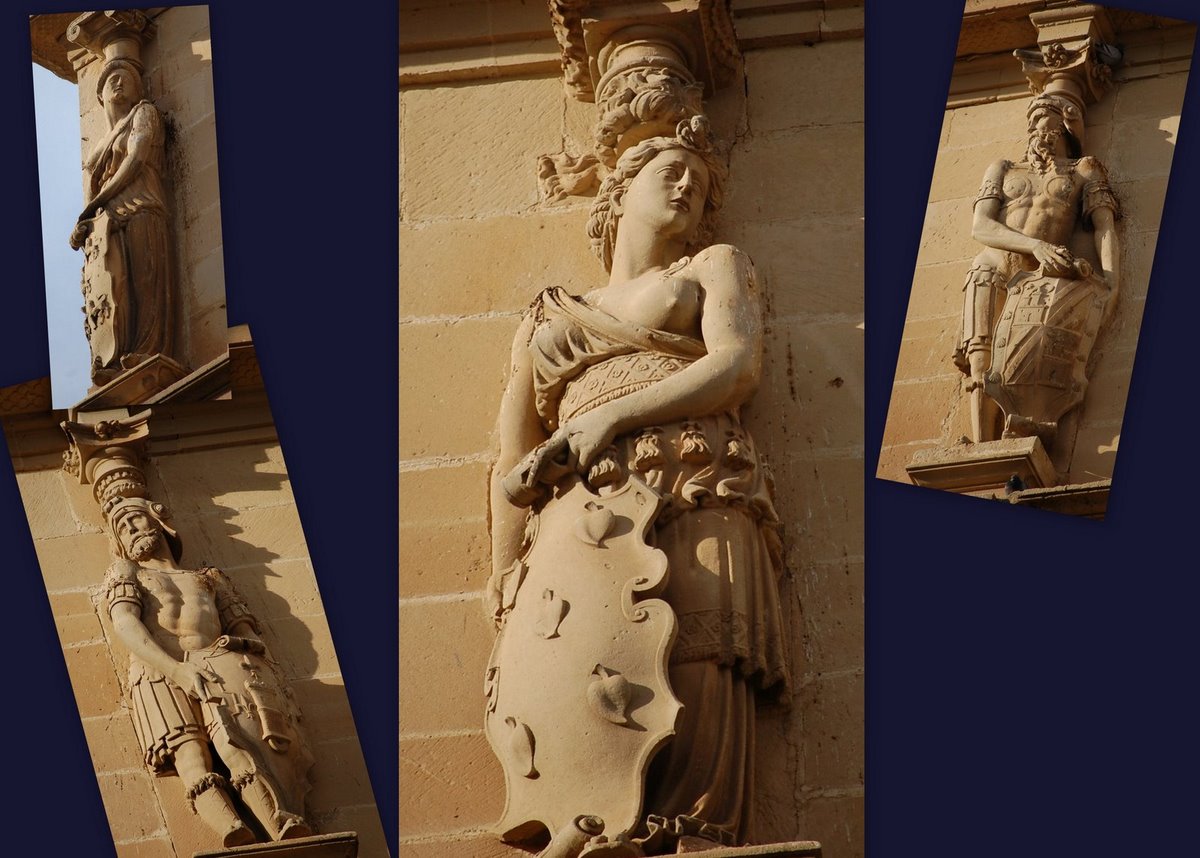 ... by 8 caryatids inspired (if
not done by) the French sculptor Esteban Jamet who was
active in Plateresque Spain around the time this was
built. Caryatids are usually female and a bit less
bellicose than what we see here (and not always as well
fed, either). The male warriors hold the coat of arms of
the family who first used this place as their palace --
the de los Cobos tribe who flourished in mid 16th
century. Inside the nearby chapel that we’ll soon
see, Jamet created many more caryatids as he brought this
classic Greek form into the High Renaissance that was
flowering in the soil of Gothic Spain.
... by 8 caryatids inspired (if
not done by) the French sculptor Esteban Jamet who was
active in Plateresque Spain around the time this was
built. Caryatids are usually female and a bit less
bellicose than what we see here (and not always as well
fed, either). The male warriors hold the coat of arms of
the family who first used this place as their palace --
the de los Cobos tribe who flourished in mid 16th
century. Inside the nearby chapel that we’ll soon
see, Jamet created many more caryatids as he brought this
classic Greek form into the High Renaissance that was
flowering in the soil of Gothic Spain.
Below is one of the turrets/viewing galleries that
straddle each end atop the Palace. This is a hexagon, a
common shape in this Renaissance town. Unlike most of the
rest of the facade, these Dorian pillars and the crowning
sculptures could use some restoration.
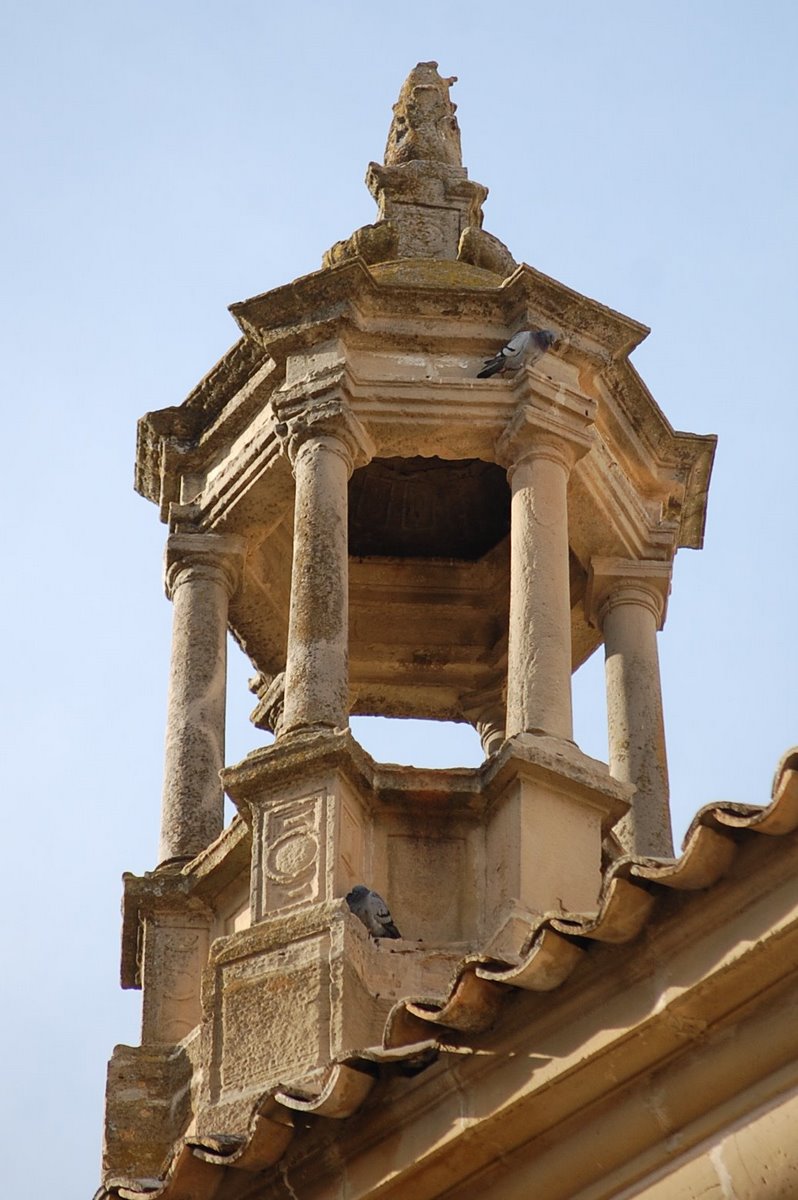 Besides being known as the palace
of chains (Cadenas), it's also called Palacio de Juan
Vázquez de Molina after the noble who paid
Vandelvira's bills. He was a member of the town's own
dynasty: the los Cobos family. More famous was his uncle,
Don Francisco de los Cobos, who served
as secretary of state for the Holy Roman Emperor Charles
V who is often considered to be the first king of Spain
(and a whole lot more territory besides). It’s
likely that Francisco de los Cobos was the 2nd most
powerful man in a Spain that had just expelled the Moors
and was creating the world’s most powerful empire.
Nephew Vázquez de Molina followed in his uncle's
footsteps and became Charles's secretary as well as that
of Charles' successor, Philip II. When these two ruled,
Spain was hands down
the world power. But this new country spent more
than it took in, and financial deficits eventually
contributed to Spain's downfall. (Aren't you glad that
can't happen today!)
Besides being known as the palace
of chains (Cadenas), it's also called Palacio de Juan
Vázquez de Molina after the noble who paid
Vandelvira's bills. He was a member of the town's own
dynasty: the los Cobos family. More famous was his uncle,
Don Francisco de los Cobos, who served
as secretary of state for the Holy Roman Emperor Charles
V who is often considered to be the first king of Spain
(and a whole lot more territory besides). It’s
likely that Francisco de los Cobos was the 2nd most
powerful man in a Spain that had just expelled the Moors
and was creating the world’s most powerful empire.
Nephew Vázquez de Molina followed in his uncle's
footsteps and became Charles's secretary as well as that
of Charles' successor, Philip II. When these two ruled,
Spain was hands down
the world power. But this new country spent more
than it took in, and financial deficits eventually
contributed to Spain's downfall. (Aren't you glad that
can't happen today!)
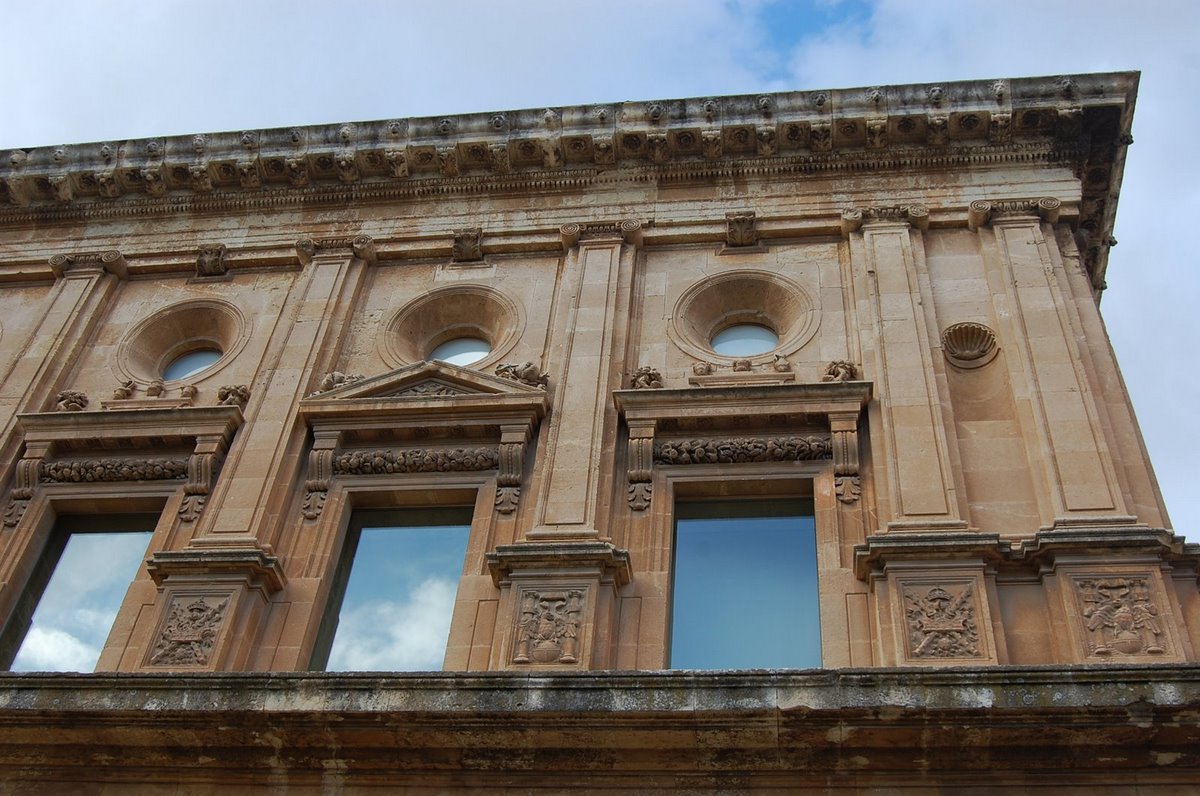
At right is another close-up of the 2nd and 3rd
stories -- actually not. These are the upper floors of
the palace of Charles V at the Alhambra in Granada.
Obviously Charles first secretary borrowed some ideas
from his Emperor. Above is probably the first Renaissance
building in Spain and precedes the Úbeda palacio
by 3 decades. It's the work of Pedro Machuca who probably
studied under Michelangelo. Vandelvira's influences are
easy to trace in stone.
Below is a shot of the graffiti found on many of the
Renaissance buildings in Andalusian Spain. It's obviously
historic, but what does it mean? Vázquez de Molina
and Vandelvira built this palace in 6 years starting in
1562. Unfortunately, de Molina had no children and so he
decided to found a religious order to take over the
place. He undoubtedly had help from his brother who was
bishop.

Fernando Ortega Salido Palace -- the Parador
The picture below looks
east from the palace across the
long rectangle that is the Plaza Vázquez de
Molina. To the left is Úbeda's old prison (right
on the street with the nobles' palaces!) In the
foreground is a Renaissance fountain. To the left center
we see our next building, the Parador hotel. In the
background is the Capilla (Chapel) of Our Savior.
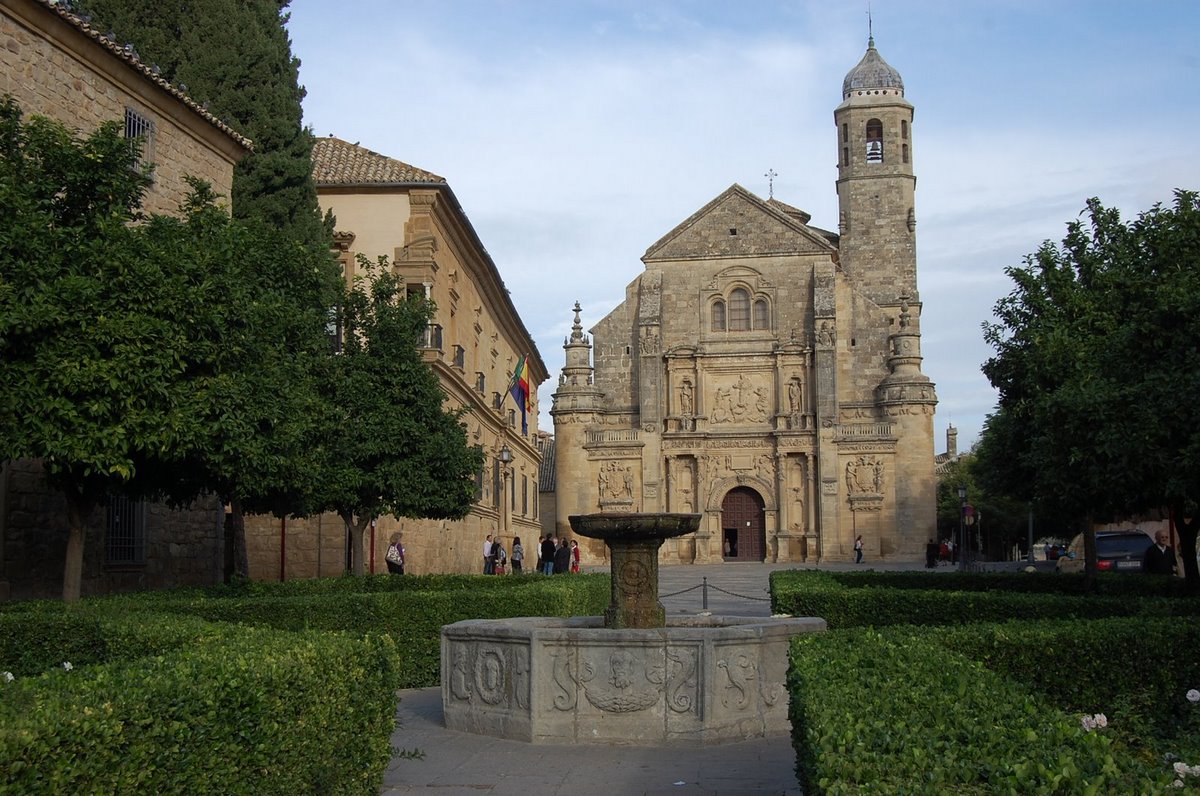 Below we look the opposite way
from the prior picture. Down the long Plaza
Vázquez de Molina is the more austere Deán
Fernando Ortega Salido Palace, another Renaissance work
of Andrés de Vandelvira. This was one of the first
Parador hotels, and was the first Parador that Dick
stayed in shortly after the global and personal darkness
of 9-11. On this trip we again used this for our
Úbeda base, looking out at this magnificent square
from the 2nd window from the left on the upper floor.
Below we look the opposite way
from the prior picture. Down the long Plaza
Vázquez de Molina is the more austere Deán
Fernando Ortega Salido Palace, another Renaissance work
of Andrés de Vandelvira. This was one of the first
Parador hotels, and was the first Parador that Dick
stayed in shortly after the global and personal darkness
of 9-11. On this trip we again used this for our
Úbeda base, looking out at this magnificent square
from the 2nd window from the left on the upper floor.
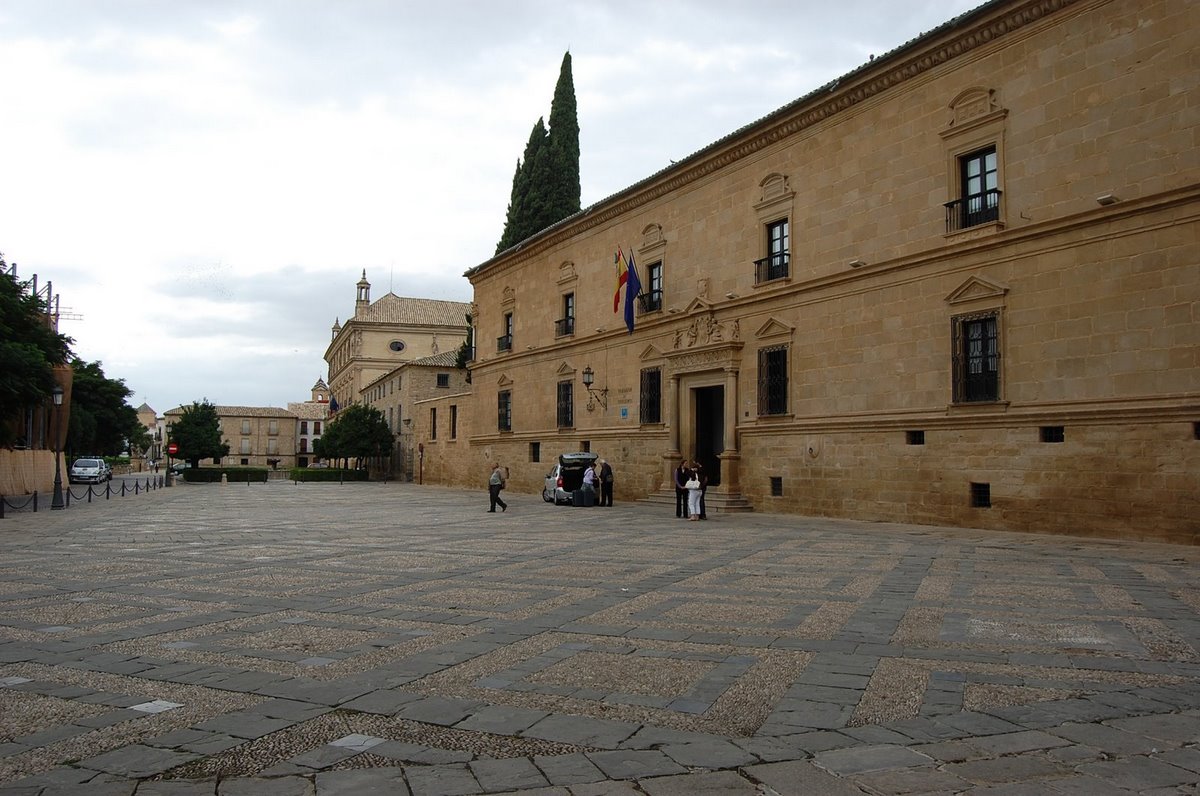
We probably had better plumbing than did the builder of
this palace: Don Fernando Ortega Salido, Dean of the
Cathedral of Malaga who, like the de los Cobos, was a
part of the Emperor's retinue. Note the lack of cars
here; no parking (other than luggage handling) is allowed
in the entire plaza. More places should do this,
especially if they look as good as Úbeda's public
squares. (On the down side, we found a few dents on our
rental car the next morning as we had to park it on the
street.)
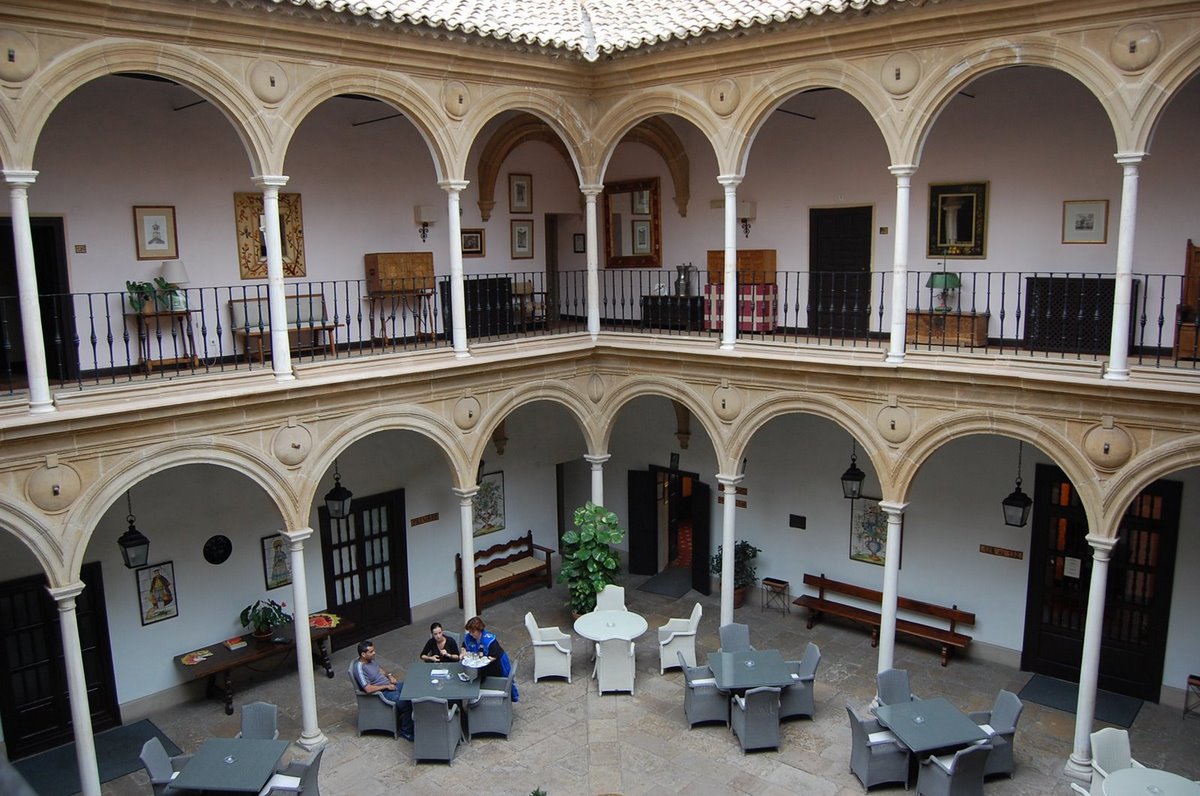
During our stay, the Parador seemed empty, especially
around dinnertime when no more than three couples would
be in the dining room. The inner courtyard was
spectacular -- and typical of Vandelvira's palace
architecture.
Let's continue our tour of the Plaza Vázquez de
Molina with the town's most spectacular building, inside
and out, the building told everyone that young
Andréa Vandelvira was to be Andalusia's Frank
Lloyd Wright: the Chapel of the Savior (Capilla del
Salvador). Join us by clicking
here.
Please join us in the following slide show to
give Úbeda the viewing it deserves by clicking here.
|
|
|
|
Geek and Legal Stuff
Please allow JavaScript to enable word
definitions.
This page has been tested in Internet
Explorer 7.0 and Firefox 3.0.
Created on 15 February 2009
|
 |
TIP:
DoubleClick on any word to see its definition.
Warning: you may need to enable javascript or allow
blocked content (for this page only).
TIP:
Click on any picture to see it full size. PC
users, push F11 to see it even larger.
<
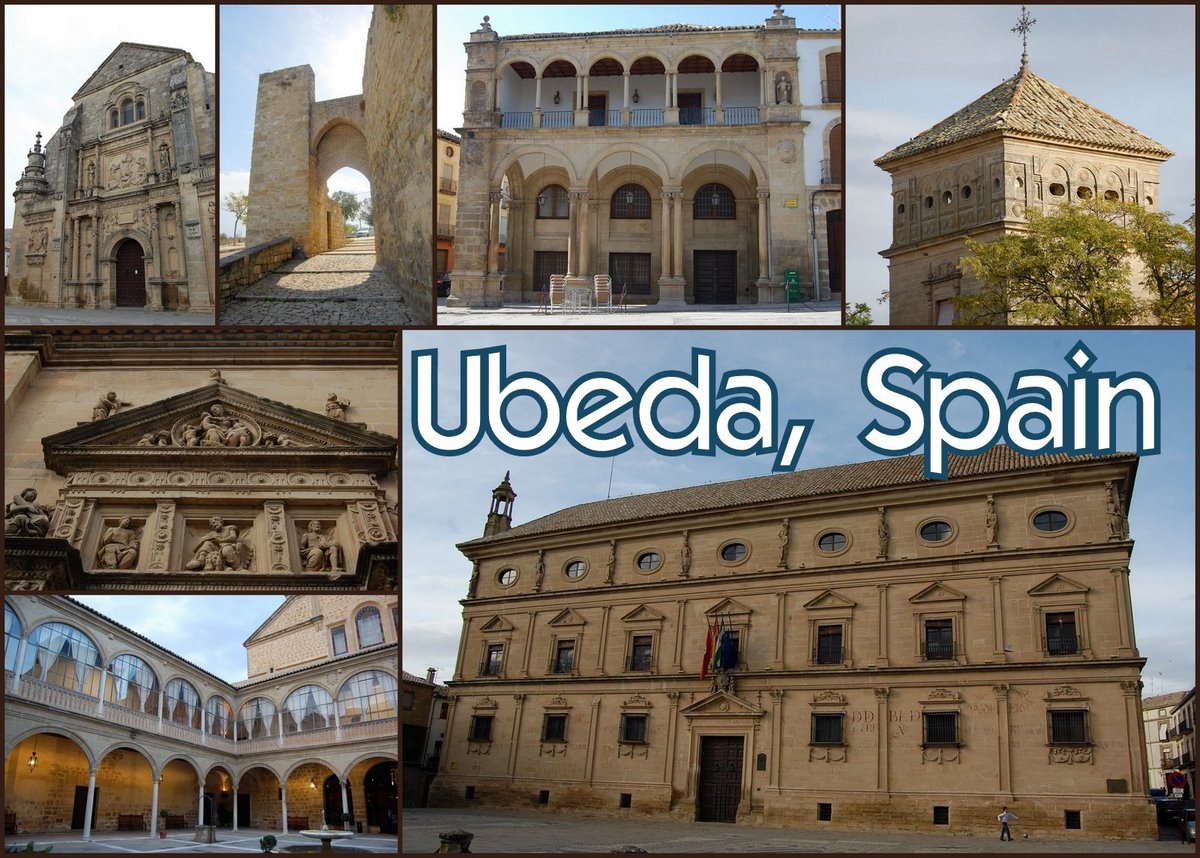


 legacy in stone here and through
his son’s writings. In a time of very little formal
training for architects, these influenced many builders
who followed. Above we look from the Palacio de las
Cadenas towards the Chapel of our Savior. Note that the
red car is parked on the street, not on the plaza. (More
on that later).
legacy in stone here and through
his son’s writings. In a time of very little formal
training for architects, these influenced many builders
who followed. Above we look from the Palacio de las
Cadenas towards the Chapel of our Savior. Note that the
red car is parked on the street, not on the plaza. (More
on that later).
 ... by 8 caryatids inspired (if
not done by) the French sculptor Esteban Jamet who was
active in Plateresque Spain around the time this was
built. Caryatids are usually female and a bit less
bellicose than what we see here (and not always as well
fed, either). The male warriors hold the coat of arms of
the family who first used this place as their palace --
the de los Cobos tribe who flourished in mid 16th
century. Inside the nearby chapel that we’ll soon
see, Jamet created many more caryatids as he brought this
classic Greek form into the High Renaissance that was
flowering in the soil of Gothic Spain.
... by 8 caryatids inspired (if
not done by) the French sculptor Esteban Jamet who was
active in Plateresque Spain around the time this was
built. Caryatids are usually female and a bit less
bellicose than what we see here (and not always as well
fed, either). The male warriors hold the coat of arms of
the family who first used this place as their palace --
the de los Cobos tribe who flourished in mid 16th
century. Inside the nearby chapel that we’ll soon
see, Jamet created many more caryatids as he brought this
classic Greek form into the High Renaissance that was
flowering in the soil of Gothic Spain.





